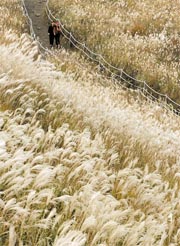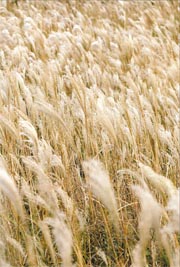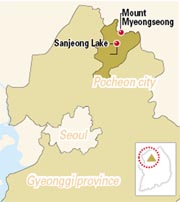Pampered with views of pampas grass

Pampas meadows burst to life on Mount Myeongseong. All phtotos by Jeong Ji-ho
Instead, Kim Hong-soo, a key member of the local community in the nearby village of Sanjeong, does the talking. “The mountain was a hard-fought battlefield during the Korean War,” Kim explained. “The fields where the pampas grass grows was originally thick with trees. After the bombs and bullets, however, it turned into this vast grassy plain.” Kim, 51, grew up hearing stories about the pampas grass from the elders in his village. He firmly believes that the pampas grass is the sad yet dazzling reincarnation of victims of the war.
The history of the mountain is steeped in tragedy. In fact, the name Myeongseong means the “sound of crying.” According to legend, the mountain wept along with the last prince of the Silla Dynasty when he fled his country in despair after its collapse.
This open pampas grass field is especially spectacular at this time of the year. The seed blooms in feather-like plumes, hanging in a whiter shade of pale from the tip of the yellow stalks. During the peak of the season, when the weather becomes more bleak, the field takes on a silvery appearance when viewed from a distance.
Viewed against the changing hue of the fall leaves, the pampas grass is a major part of the autumnal feast that Korea offers visitors during these cooler months, and the area is relatively easy to reach from Seoul.
Fittingly, the Pocheon city government is holding a pampas grass festival through this Sunday. The program includes rock bands and different kinds of dance performances. However, visitors wanting to enjoy the pampas grass aren’t bound by this festival date. The natural beauty of the grass shines through early November. So if you want to experience the true charm of the surrounding scenery, you might want to skip the festival and head straight to the entrance to the mountain by Sanjeong Lake, a popular tourist destination for Koreans.
One thing visitors should bear in mind, though, is that several military bases are located nearby and one side of the mountain is reserved for military drills, especially rifle practice. You’ll see several signs warning “Beware of military installations.” Except during the festival, the mountain is sometimes closed on weekdays for target practice. So it’s best to check ahead to see if the mountain is open or not by calling the Sanjeong Lake office at (031) 532-6135.

To be honest, the climb up the mountain can be challenging if you aren’t prepared for rocky paths and slippery mud. Comfortable shoes are a must, preferably hiking boots. I didn’t expect the trip to be so demanding. Just a stroll in the park, I thought. But nothing ventured, nothing gained, and I set off to find the famed grass.
At this time of year the mountain is patterned with colorful leaves and the valleys resound with the gurgling of crystal-clear water running through the streams and powerful waterfalls like Deungryong Falls, meaning the “Fall of the Rising Dragon,” plummeting off the giant granite cliffs. These are excellent scenic spots for hikers to appreciate views of the leaves turning red and yellow as autumn gathers and to contemplate the natural beauty of the surroundings.
After walking, and sometimes leaping from rock to rock, for 90 minutes along the path up to the peak, the soil becomes dark and damp. This is a sign that you are nearing your destination. Keep walking and you’ll soon come across an open field full of pampas grass gently dancing in the wind. All you and your fellow hikers can do now is stand back in awe. Wherever you look, you are struck by the sight of the swaying pampas grass.
Oh Hyun-jeong, 45, a housewife from Seoul, was one such onlooker last Monday afternoon. “I’ve visited many pampass grass spots around the country, but this is the best,” Oh said, clutching her husband’s hand. Oh was not the only one enjoying a romantic stroll last Monday. Several lovebirds were scattered here and there, proving that hiding under the canopy of pampas grass is indeed the best place to whisper sweet nothings. But even if you are not armed with a significant other as you venture forth along this trail, don’t lose heart. The narrow paths that weave through the pampas grass fields provide scenes bewitching enough for lone travelers as well. A vista of the wind soughing through the pampas grass provides a soothing antidote to life’s troubles and stresses, no matter the state of your love life.

“We should come here again,” murmured Oh, as she made her way back. And she was not alone. Many pampas grass gazers felt the same way, myself included.
Mount Myeongseong is about a two-hour drive from central Seoul, barring heavy traffic. Take the 43rd National Highway from Uijeongbu, Gyeonggi, pass Pocheon village and take a right turn at the Munam Samgeori intersection. Follow the road in the direction of Sanjeong Lake, which is right next to the mountain. Or you can go to Uijeongbu subway station, line No. 1, and take a 90-minute ride on bus No. 138-6. For further information, call the Pocheon city office at (031) 538-2069.
If you don’t have time to go to the suburbs, some parts of Seoul also have pampas grass. You can head to the World Cup Park via World Cup Park subway station, line No. 6, exit 1.
If you want to venture further into Gangwon, you might consider Mount Mindung which is also noted for its pampas grass vista and leisurely trails through the countryside.
This mountain is also luring tourists with a pampas grass festival running through this Sunday. For more information, call the Jeongseon city office at (033) 560-2578.
By Chun Su jin [sujiney@joongang.co.kr]










with the Korea JoongAng Daily
To write comments, please log in to one of the accounts.
Standards Board Policy (0/250자)